Of all the cultures and people that make up the rich tapestry that is human history, the Vikings are in a class all by themselves in terms of recognition, popularity, and perhaps even infamy.
Everyone, it seems, including popular TV series and video games, has a similar perception of how the Vikings looked.
But is the popular portrayal of Vikings based on historical truth or rooted in myth and fantasy?
By piecing together clues left behind by the Vikings themselves and those who encountered them, historians believe the Vikings:
- Looked similar between genders
- Were of mixed ethnicities
- Were not all blondes
- Were short by today’s standards
- Wore simple, homemade clothing
- Were not all blue-eyed
The Vikings did not maintain written records of their own history and culture, so much of what the Vikings may have looked like is left to the imagination of Hollywood screenwriters and film directors.
But thanks to devoted scientists and historians, a clearer picture of what the Vikings actually looked like is coming into focus.
Keep reading to learn more about the Vikings as the divide between truth and fiction grows larger and deeper.
Viking women play an important role in Viking society. See 15 Facts About Viking Women to learn more.

What did the Vikings’ Faces Look Like?
Popular opinion and mainstream media depict the Vikings in a similar fashion. The men sport scraggly beards and brutish, battle-worn facial features.
While perhaps not homely in appearance, the women nevertheless possess an edgy, rustic look befitting the harsh living conditions of Scandinavia during the Viking Age.
In reality, what the Vikings’ faces looked like centuries ago is something of an educated guess at best.
There are no reliable records or artifacts (e.g., portraits or detailed descriptions) accurately depicting the Vikings. (Also see What Did the Vikings Wear?)
Still, scholars can surmise certain facial characteristics from the numerous skeletal remains (specifically, the skulls) that have been recovered from known Viking settlements.
Some of the findings that have been revealed by scientific studies are somewhat surprising:
- Unlike the distinguishable facial features that are evident in Scandinavian males and females today, the faces of Viking men and women centuries ago were not all that different from each other [1]
- In fact, male Vikings had softer jawlines that gave them a more feminine appearance, and conversely, female Vikings had a more pronounced bone structure in the ridges above the eyes, giving them a more masculine look [2]
- At first glance, even to a trained eye, it is difficult to differentiate male Vikings skulls from those belonging to female Vikings (archaeologists must often look to the pelvic bones to determine the gender of Viking skeletal remains)
The Vikings’ hairstyles might surprise you. See What Kind of Hairstyles Did the Vikings Have? to learn more.
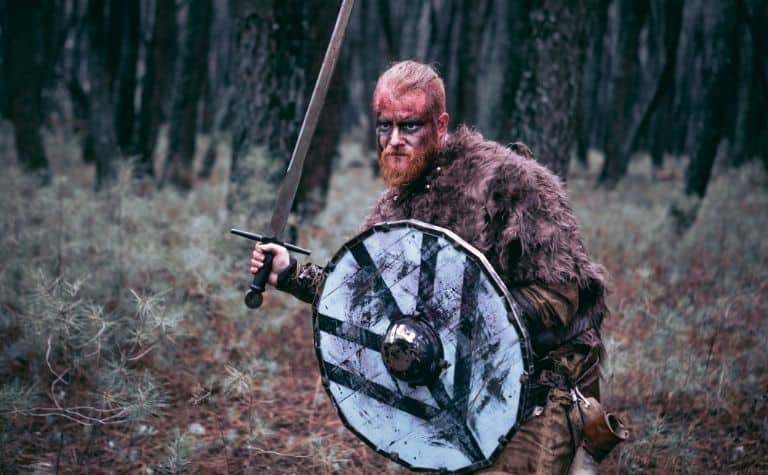
Did the Vikings Wear Makeup?
If Hollywood directors are to be believed, the Vikings painted their faces with copious amounts of, and in various shades of, a blue and black pigment in order to intimidate their enemies on the fields of battle.
Such exploits are not mentioned in Norse sagas, nor have any archaeological artifacts been discovered that lend credence to such assertions.
However, there are third-party accounts from reliable historical sources indicating that the Vikings did wear makeup, specifically eyeliner.
During a visit to the bustling Viking marketplace known as Hedeby (located in modern-day Germany) in 950 AD, an Arab emissary named Ibrahim Al-Tartushi observed that Vikings of both sexes wore dark, permanent makeup around their eyes, and “beauty increases among men and women.” [3]
It is believed that this medieval eyeliner was, in fact, kohl, a dark-colored cosmetic that was popular in areas of the Middle East, the Mediterranean, and parts of northern Africa.
Also known as kuhl in Arabic. The Viking eye makeup was likely produced from a mixture of:
- Ground antimony
- Burnt almonds
- Lead
- Oxidized copper
- Ochre
- Ash
- Malachite
- Chrysocolla [4]
Aside from enhancing their appearance (at least, by Viking Age standards), the black eyeliner worn by the Vikings may have also had the practical effect of reducing glare from the sun, much like the eye black worn by many baseball and football players today.
Did the Vikings have permanent marks on their skin? See Did the Vikings Have Tattoos? to learn more.
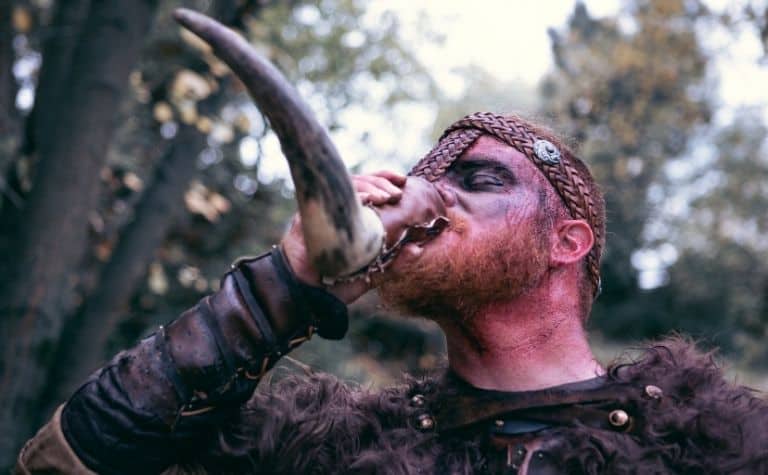
What Race Were the Vikings?
The Vikings are something of an enigma largely because the ancient Norse people did not document themselves, and therefore, the historical record lacks reliable material about them.
Many of the current perceptions about the Vikings are based more on conjecture than on irrefutable fact, including the widely-held assumption that they were predominantly blonde-haired, blue-eyed Caucasians.
What is known about them today is largely the result of backbreaking archaeology and meticulous research.
One prevailing question is whether the Vikings were a distinct race of people or a melting pot of regional civilizations.
What insights the Vikings themselves did not provide, science is starting to reveal and, in the process, fill in these information gaps. (Also see Were There Any Black Vikings?)
For instance, a genetic analysis of over 400 Viking skeletal remains painstakingly gathered from sites throughout Scandinavia and extending to areas as wide-ranging as Greenland to the west and Ukraine to the east has revealed some rather startling facts:
- Individual skeletons buried in Viking graves were found to be completely lacking in Scandinavian DNA, suggesting that non-Scandinavian people joined Viking ranks as they swept throughout Northern Europe [5]
- Some DNA recovered from Viking burial sites in Norway contained genetic markers indicating Saami lineage (indigenous peoples who pre-dated the Vikings in Scandinavia), who themselves have more in common on a genetic level with Asians and Siberians than with Europeans
- Generally speaking, Viking-age Scandinavians had a higher proportion of brunettes among their ranks than their modern-day counterparts
- One particularly distant strain of DNA found in Danish and Swedish skeletons could be traced to the ancient Anatolia region (which is modern-day Turkey) [6]
These findings demonstrate that there was a significant influx of genetic influences into Scandinavia from Asia and southern Europe before and in the midst of the Viking Age.
And as it turns out, the genetic material highway flowed both ways. [7]
Scientists have found Scandinavian genetic markers in modern-day populations throughout Europe supporting long-held beliefs that:
- Vikings from what is now Norway settled in parts of Ireland, Scotland, Iceland, and Greenland
- Danish Vikings established themselves in England
- People from Viking Age Sweden headed east to areas that are now the Baltic countries
The Vikings are known as fierce warriors. See What Weapons Did the Vikings Use? to learn more.

What Color Hair Did the Vikings Have?
Although archaeological discoveries of Viking weapons caches and treasure troves make for the biggest headlines, personal grooming items are among the most common Viking artifacts that have been recovered.
Included among these are exquisitely crafted combs that strongly suggest that the Vikings cared greatly about their personal appearance, and in particular, their hairstyles.
There is a wide consensus among historians that the common perception that all Vikings had blonde hair is simply inaccurate.
Scientific evidence supports the notion that there was a variety of hair colors among the Vikings, with some genetic research suggesting that Vikings hailing from what is now Denmark were often redheads. [8]
Other scientific data suggesting that there were more dark-haired Danish Vikings back then than there are brunettes in Denmark today. [9]
And as it turns out, Norsemen from the northern reaches of Scandinavia (e.g., modern-day Sweden) were more often than not blonde-haired, as are so many Swedes in the modern era.
Did the Vikings Prefer Blonde Hair?
While there was a fair share of blond, brunette, and red-haired Vikings over a millennium ago, scholars believe that as far as personal appearance was concerned, there did seem to be a general preference for blonde hair among Viking men and women.
To illustrate this point, Norse sagas advise exercising caution around dark-haired people, who are predisposed to melancholy and unstable. [10]
For those who were not blessed with naturally golden locks, a popular homemade concoction could transform just about any color hair into varying degrees of blonde.
As it turns out, whether, by intent or happenstance, the soap used by Vikings for bathing and washing their hair had the fortuitous side effect (or perhaps, purpose) of bleaching their hair. [11]
- A common Viking method for making soap involved combining animal fat with wood ash (essentially lye)
- The resulting mixture was highly alkaline and had a lightening effect when left in the hair
- By adjusting the amount of lye in the soap, the bleaching effect could be increased or decreased
- Celtic men used the same technique to redden their hair
- The strong lye soap used by the Vikings had the bonus effect of ridding their hair of head lice
See the article The Norse Tree of Life to learn about one of the most important and interesting Viking symbols.
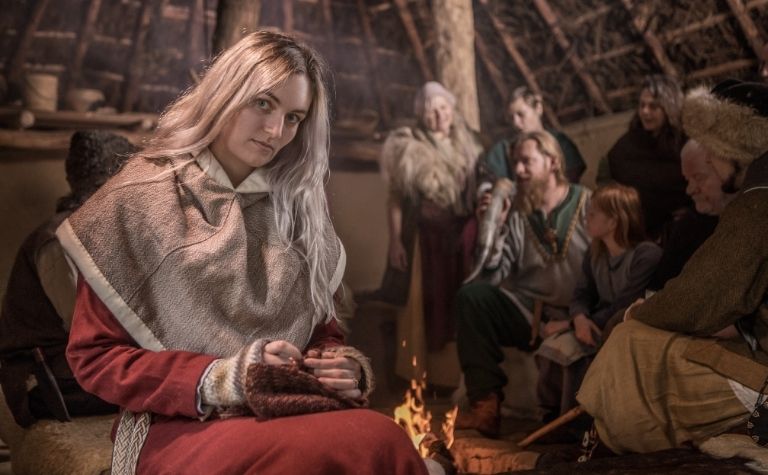
How Tall Were the Vikings?
If the harrowing accounts of Viking raids and conquests are to be believed, the warrior Norsemen were larger-than-life figures whose imposing physical attributes added an element of intimidation to their violent ways.
While some historical sources may be more credible than others, there are multiple accounts describing the Vikings’ impressive stature. [12] (See the full article Were the Vikings Tall?)
- One account from Saxony (modern-day Germany) in 884 AD describes the physical characteristics of the invading Vikings as never having “been seen before among the Frankish people, namely in their beauty and the size of their bodies”
- Even in the commercial realm, Vikings made a strong impression as the Arab diplomat Ibn Fadlan noted when encountering them in trading circles, “I have never seen more perfect physical specimens, tall as date palms”
These eyewitness accounts portray the Vikings as having extraordinary qualities, chief among them their height. Rather than being six-plus feet tall, however, scientists have determined that the Vikings were significantly shorter than they were made out to be by those who encountered them.
Studies of hundreds of Viking skeletal remains recovered from sites throughout Scandinavia reveal just how tall the Vikings actually were:
- Viking men were, on average, around 172 cm (roughly 5’ 7”)
- Viking women were, on average, around 158 cm (roughly 5’ 2”)
- These figures are approximations based on bone lengths
On average, the Vikings were actually 8-10 cm (roughly 3-4 inches) shorter than average heights today. However, it should be noted that the Vikings were considered tall for that region, and during that era, in history. [13]
People, in general, were much shorter centuries ago simply because diets were not nearly as balanced and nutritious as they are today.
Who are the most well-known Vikings in history? See 10 Famous Vikings from History to learn more.
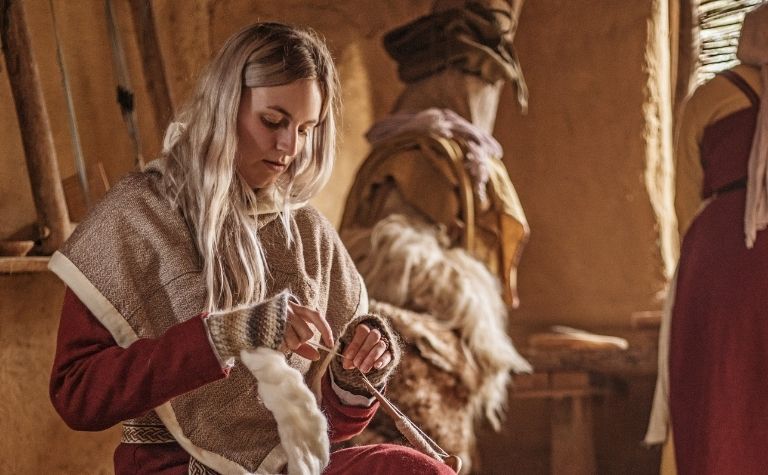
What Clothes Did the Vikings Wear?
Unlike weapons, jewelry, and even skeletal remains, clothing does not emerge intact after centuries buried in the soil.
Fortunately, enough fragments of cloth have been recovered by archaeologists to enable the methodical piecing together of the types of garments worn by Viking men and women over a millennium ago.
There is a common perception that the Vikings, and perhaps Europeans in general during the Middle Ages, wore drab and dull clothing that was reflective of the miserable living conditions of the times.
In reality, however, there is ample evidence showing that the Vikings were quite fond of colorful clothing, and in particular, garments featuring reds and blues. [14]
The Vikings were no strangers to fine fabrics like silk and ornamental details on clothing like ribbons and fancy buttons. But for the average Norse citizen, these luxuries were far beyond reach.
The realities of the Scandinavian climate in which they lived and the challenging conditions of life in the Middle Ages were determining factors in the types of clothing worn by Viking men and women.
The Clothing Worn by Viking Men
Contrary to common perception, not all Viking men went on raids or fought in bloody battles.
In fact, the majority of the Viking males stayed on the homestead, hunting and gathering food and working in the fields to provide sustenance for their families.
As such, garments worn by men had to have the following characteristics by sheer necessity:
- Be durable enough to withstand the rigors of physical labor day in and day out, as well as the harsh climate conditions of life in Scandinavia
- Many men’s garments, particularly outer layers, were made from wool which could provide precious warmth even when wet
- Inner clothing layers such as undergarments were fashioned from linen which was produced using locally grown flax [15]
The typical daily outfit of a Viking male likely consisted of a shirt, trousers, and a loose-fitting tunic.
In colder weather, men wore wool leggings over their calves and a thick cloak fastened over one shoulder, leaving the other arm free to wield a sword whenever needed.
The Vikings were a creative and expressive people. See Traditional Viking Art: Styles in the Viking Age to learn more.
The Clothing Worn by Viking Women
Like their male counterparts, Viking women wore garments fashioned from linen for layers next to their skin, like under-dresses and wool for warmth and durability for outer garments. [16]
Female Vikings were considered the managers of their households and, as such, had wide-ranging responsibilities that included cooking, caring for children, and making clothing, just to name a few.
The staple garment worn by Viking women was the strap dress (also known as an apron dress) which had the following characteristics:
- It was held up by two large straps, one over each shoulder, and fastened by some type of clasp or brooch (wealthier Viking women would have worn ornamental brooches)
- Viking strap dresses were usually long-sleeved and typically went down to the ankles
- Like their men, Viking women commonly wore wool cloaks during the winter months to protect them from harsh conditions [17]
Viking footwear that both women and men wore typically consisted of wool socks, which not only kept feet warm but were durable as well.
They also wore shoes or boots made from animal hides such as goatskin. Animal furs were used for trim on the outerwear worn by both sexes.
The Vikings were surrounded by game, fish, birds, and fruits and vegetables. See What Did the Vikings Eat? to learn more.
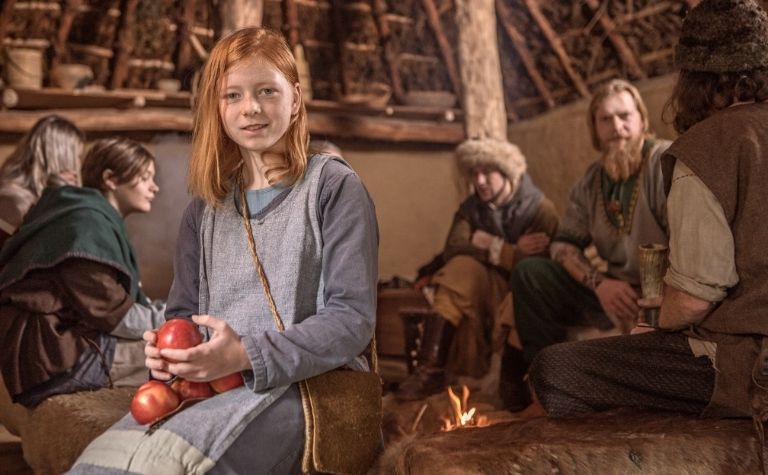
What Color Eyes Did Vikings Have?
Just as scientific data acquired through the DNA sequencing of hundreds of Viking skeletons have revealed that not all Norsemen were blond-haired, the same research shows that they were not all blue-eyed either. [18]
In fact, scientists are now convinced that a significant number of Vikings had dark-colored eyes like brown or hazel.
As part of the same study, Viking skeletons recovered in Ireland (where the Viking legacy is strong, particularly in Dublin, which was founded by the Norse invaders) had their DNA analyzed. [19]
The resulting genome sequencing revealed that some of the skeletal remains could be traced to Norwegian lineage and that the probable hair and eye colors were both brown.
While science has demonstrated that Viking eye colors included brown and other dark hues, it is beyond dispute that blue eyes remain the dominant eye color throughout Scandinavia.
A recent survey of nations with the highest percentages of people with blue eyes (and blond hair) shows that Denmark, Norway, and Sweden rank among the top ten in the world:
- Sweden – Ranked 4th (70-80% of Swedes have blue eyes)
- Norway – Ranked tied for 5th (50-80% of Norwegians have blue eyes)
- Denmark – Ranked tied for 5th (50-80% of Danes have blue eyes) [20]
Interestingly, the nation ranked number one in terms of the percentage of people with blue eyes is Iceland (90% of Icelanders), and this island nation was settled by Vikings centuries ago.
The Main Takeaway
In somewhat of a surprising twist, DNA analysis of skeletal remains recovered from a broad swath of Europe and Greenland have revealed that the Vikings were not a homogeneous group of people with a close range of physical characteristics.
Rather, they were a diverse group of gene pools and corresponding attributes gathered from Europe and beyond.
While hard scientific evidence may have busted a few myths or misconceptions about the Vikings, such as their hair, eye color, or other physical attributes, they have done nothing to diminish their historical stature.
Whether they were blondes or six-and-a-half feet tall, the Vikings were, and still remain, one of the most celebrated and enigmatic people to have ever lived.
Conclusion
Thanks to modern science, an accurate picture of what Viking men and women really looked like is coming into clearer focus.
References:
[1] Source
[2] Source
[3] Source
[4] Source
[5] Source
[6] Source
[7] Source
[8] Source
[9] Source
[10] Source
[11] Source
[12] Source
[13] Source
[14] Source
[15] Source
[16] Source
[17] Source
[18] Source
[19] Source
[20] Source
